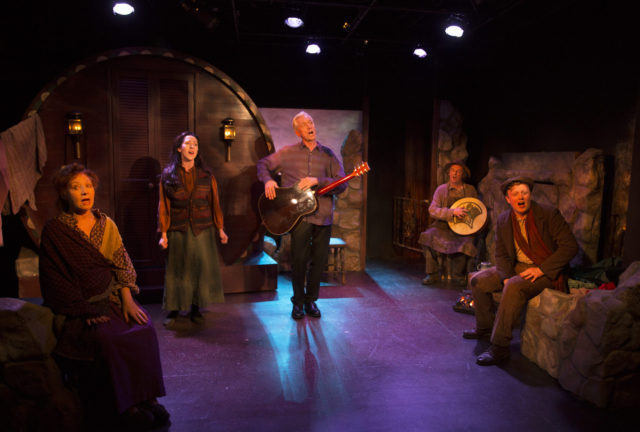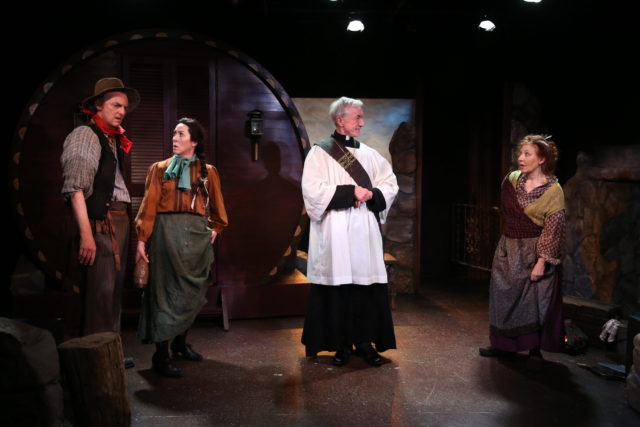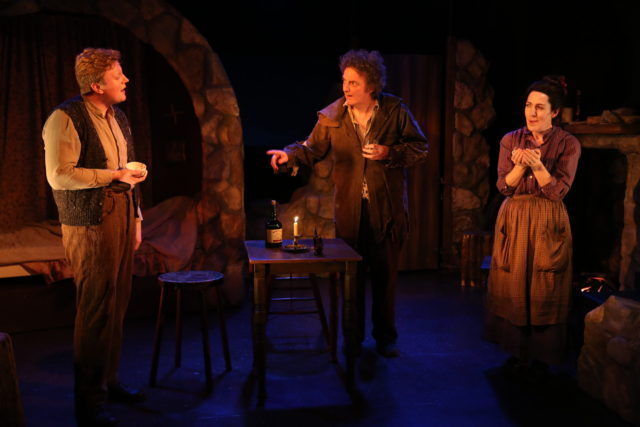
The Irish Rep’s Two by Synge features several musical interludes (photo by Carol Rosegg)
TWO BY SYNGE: IN THE SHADOW OF THE GLEN / THE TINKER’S WEDDING
Irish Repertory Theatre, W. Scott McLucas Studio Theatre
132 West 22nd St. between Sixth & Seventh Aves.
Wednesday – Sunday through May 22, $50
212-727-2737
irishrep.org
I am here to sing — pun intended — the praises of the great John Keating, currently starring in the theatrical twinbill Two by Synge: In the Shadow of the Glen & The Tinker’s Wedding at the Irish Rep. It’s a rave long in coming. If you don’t know the name, you must not have visited the Irish Rep much in the last quarter century, during which time the Tipperary native has appeared in more than a dozen productions (as well as numerous Shakespeare adaptations at TFANA).
Keating, a wiry fellow who stands six-foot-three with wildly curly hair and an immediately recognizable face, portrayed the fearful, deeply religious Shawn Keogh in John Millington Synge’s Playboy of the Western World at the Irish Rep in 2002; he is not the same John Keating who illustrated a 1927 edition of the work.
Directed by Irish Rep founding artistic director Charlotte Moore, Two by Synge consists of a pair of early short works about Irish peasantry, which the Dublin-born Synge based on stories he heard and saw, then wrote about at the urging of his friend and colleague W. B. Yeats. They take place in the company’s downstairs W. Scott McLucas Studio Theatre, a tiny, intimate black box where you can practically reach out and touch the actors — while getting the sensational opportunity to revel in Keating’s extraordinary talent.
It begins with The Tinker’s Wedding, Synge’s bawdy tale of a poor couple, Sarah Casey (Jo Kinsella), the onetime Beauty of Ballinacree, and Michael Byrne (Keating), a tinker, who want to get married. Their relationship is more out of necessity than true love.

A couple of peasants want the local priest to marry them in The Tinker’s Wedding (photo by Carol Rosegg)
Sarah harasses Michael, arguing, “It’ll be small joy for yourself if you aren’t ready with my wedding ring. Is it near done this time, or what way is it at all?” He replies, “A poor way only, Sarah Casey, for it’s the divil’s job making a ring, and you’ll be having my hands destroyed in a short while the way I’ll not be able to make a tin can at all maybe at the dawn of day.” Sarah says, “If it’s the divil’s job, let you mind it, and leave your speeches that would choke a fool.” Michael retorts, “And it’s you’ll go talking of fools, Sarah Casey, when no man did ever hear a lying story even of your like unto this mortal day. You to be going beside me a great while, and rearing a lot of them, and then to be setting off with your talk of getting married, and your driving me to it, and I not asking it at all.”
Sarah tries to force the local priest (Sean Gormley) to perform the ceremony, but he is not about to do so without getting some form of payment, as Sarah and Michael are not church regulars and she does not live the life of a model Christian. “A holy pair, surely! Let you get out of my way,” the harried priest declares, attempting to leave them, but Sarah is adamant. Soon arriving is Michael’s mother, Mary (Terry Donnelly), a well-known drunk who has a way of ruining everything. She tells the priest, “Isn’t it a grand thing to see you sitting down, with no pride in you, and drinking a sup with the like of us, and we the poorest, wretched, starving creatures you’d see any place on the earth?” When the priest threatens again to not marry the couple, Sarah and Michael come up with a bizarre plan to ensure their union.
The Tinker’s Wedding — which Synge never got to see performed, as he died of Hodgkin’s lymphoma at the age of thirty-seven, more than seven months before its 1909 debut — is a bit too jumbled at first but eventually finds its legs. Daniel Geggatt’s set features stone walls, a fireplace, a small gate, and the facade of a house that resembles a huge Native American drum. Keating is a joy to watch, whether he is front and center or drifting off into the background, tinkering with the ring or a tin can. In full character, he follows the action with intricate gestures, from smiles and nods of agreement to frowns and head shakes. His eyes gape open in wonder and shudder in fear. While that might be what good acting is about, he takes it to another level, in the simplest moments as well as the turning points.
Keating (The Naturalists, The Winter’s Tale) is even better in the second play, the significantly superior In the Shadow of the Glen, the first of Synge’s works to be staged (in 1903). Keating plays a tramp in a shoddy coat (courtesy of costume designer David Toser) who has wandered in from a storm to seek temporary shelter in the home of Nora Burke (Kinsella) and her husband, Dan (Gormley), who is lying lifeless in the bed. (The set is essentially the same save for the “drum,” which has been rotated to reveal the bedroom.) She seems relatively nonplussed by the corpse, and the tramp is taken aback.
“It’s a queer look is on him for a man that’s dead,” the tramp points out. Nora responds, “He was always queer, stranger, and I suppose them that’s queer and they living men will be queer bodies after.” The tramp adds, “Isn’t it a great wonder you’re letting him lie there, and he is not tidied, or laid out itself?” She answers, “I was afeard, stranger, for he put a black curse on me this morning if I’d touch his body the time he’d die sudden, or let any one touch it except his sister only, and it’s ten miles away she lives in the big glen over the hill.” Tramp: “It’s a queer story he wouldn’t let his own wife touch him, and he dying quiet in his bed.” Nora: “I’m thinking many would be afeard, but I never knew what way I’d be afeard of beggar or bishop or any man of you at all. It’s other things than the like of you, stranger, would make a person afeard.”
The tropes of a classic ghost story turn on a fabulous plot twist and the arrival of the Burkes’ neighbor, young farmer Micheal Dara (Ciaran Bowling) — the character Keating played in his first professional performance in 1994 — in whom Nora sees a rescuer from her sudden predicament. “What way would I live and I an old woman if I didn’t marry a man with a bit of a farm, and cows on it, and sheep on the back hills?” she asks.

A tramp finds himself caught between a young farmer (Ciaran Bowling) and a woman (Jo Kinsella) mourning her husband in J. M. Synge’s In the Shadow of the Glen (photo by Carol Rosegg)
Keating (Autumn Royal, The O’Casey Cycle) is again magnificent in Glen, his body movements and shifting of his eyes utterly hypnotizing. He is an actor’s actor, making everyone around him better; watching him watching the other characters also offers another way into the play for the audience, no matter how successful it already is, and In the Shadow of the Glen is just that, a short but satisfying foray into the fear of death that hovers over Irish stories. Moore (The Streets of New York, The Playboy of the Western World) and lighting designer Michael O’Connor makes sure to never have Keating fade too far into the background as members of the rest of the fine cast take center stage.
The two shows, which total seventy-five minutes, also include six songs, two by Synge, three traditionals, and one original by Gormley, “A Smile upon My Face,” which comes between the two comedies. Yes, despite such lines as “It’s a cruel and a wicked thing to be bred poor,” said by Sarah Casey, Two by Synge is very funny.
In his preface to The Tinker’s Wedding, the playwright explained, “The drama is made serious — in the French sense of the word — not by the degree in which it is taken up with problems that are serious in themselves, but by the degree in which it gives the nourishment, not very easy to define, on which our imaginations live. We should not go to the theatre as we go to a chemist’s, or a dram-shop, but as we go to a dinner, where the food we need is taken with pleasure and excitement. . . . Of the things which nourish the imagination humour is one of the most needful, and it is dangerous to limit or destroy it. Baudelaire calls laughter the greatest sign of the Satanic element in man; and where a country loses its humor, as some towns in Ireland are doing, there will be morbidity of mind, as Baudelaire’s mind was morbid. In the greater part of Ireland, however, the whole people, from the tinkers to the clergy, have still a life, and view of life, that are rich and genial and humorous. I do not think that these country people, who have so much humor themselves, will mind being laughed at without malice, as the people in every country have been laughed at in their own comedies.”
Whenever you’re not sure if something is funny or not, just follow Keating’s lead and he’ll make sure you’re on the right path.